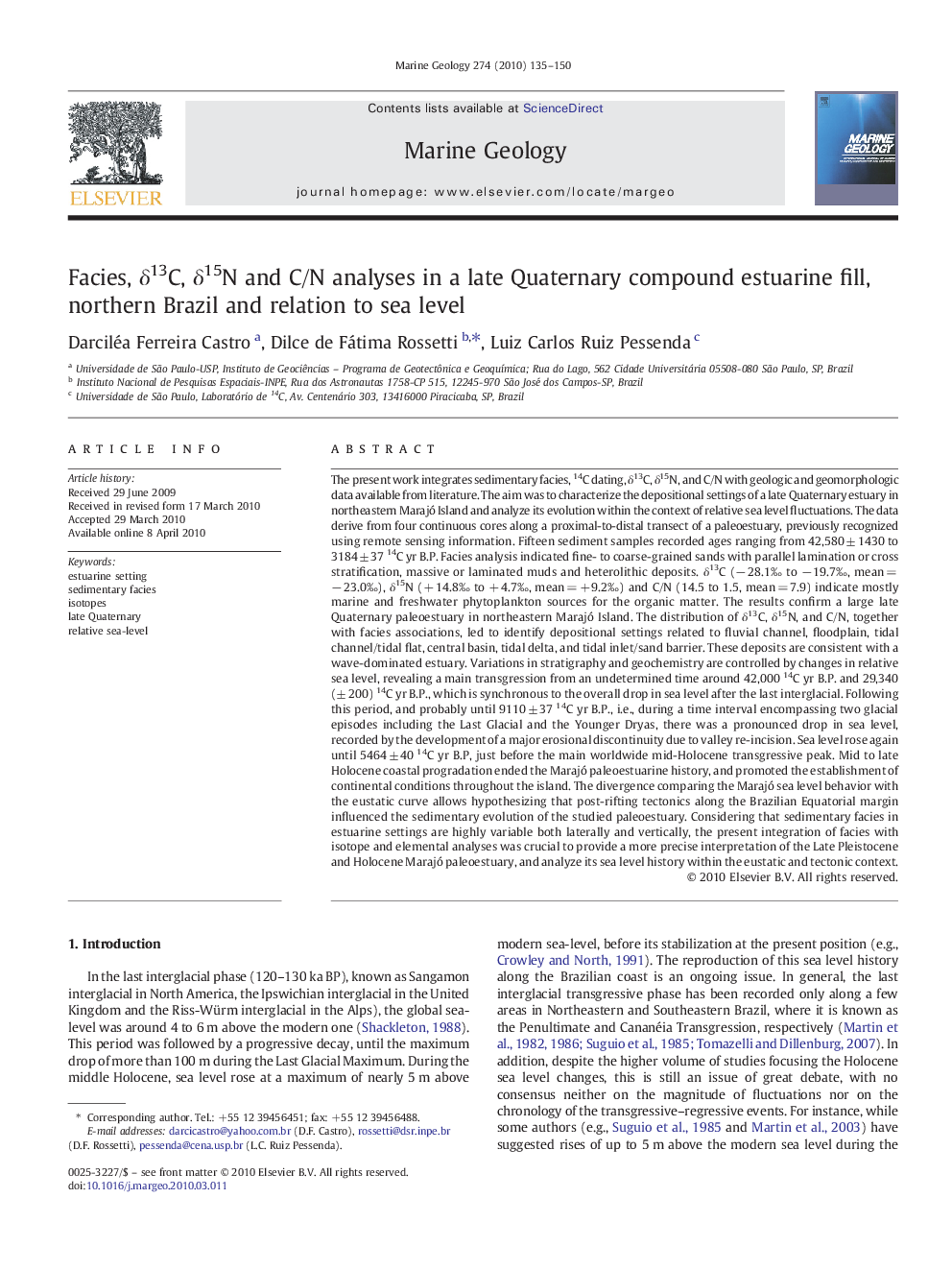| کد مقاله | کد نشریه | سال انتشار | مقاله انگلیسی | نسخه تمام متن |
|---|---|---|---|---|
| 4718932 | 1639147 | 2010 | 16 صفحه PDF | دانلود رایگان |

The present work integrates sedimentary facies, 14C dating, δ13C, δ15N, and C/N with geologic and geomorphologic data available from literature. The aim was to characterize the depositional settings of a late Quaternary estuary in northeastern Marajó Island and analyze its evolution within the context of relative sea level fluctuations. The data derive from four continuous cores along a proximal-to-distal transect of a paleoestuary, previously recognized using remote sensing information. Fifteen sediment samples recorded ages ranging from 42,580 ± 1430 to 3184 ± 37 14C yr B.P. Facies analysis indicated fine- to coarse-grained sands with parallel lamination or cross stratification, massive or laminated muds and heterolithic deposits. δ13C (− 28.1‰ to − 19.7‰, mean = − 23.0‰), δ15N (+ 14.8‰ to + 4.7‰, mean = + 9.2‰) and C/N (14.5 to 1.5, mean = 7.9) indicate mostly marine and freshwater phytoplankton sources for the organic matter. The results confirm a large late Quaternary paleoestuary in northeastern Marajó Island. The distribution of δ13C, δ15N, and C/N, together with facies associations, led to identify depositional settings related to fluvial channel, floodplain, tidal channel/tidal flat, central basin, tidal delta, and tidal inlet/sand barrier. These deposits are consistent with a wave-dominated estuary. Variations in stratigraphy and geochemistry are controlled by changes in relative sea level, revealing a main transgression from an undetermined time around 42,000 14C yr B.P. and 29,340 (± 200) 14C yr B.P., which is synchronous to the overall drop in sea level after the last interglacial. Following this period, and probably until 9110 ± 37 14C yr B.P., i.e., during a time interval encompassing two glacial episodes including the Last Glacial and the Younger Dryas, there was a pronounced drop in sea level, recorded by the development of a major erosional discontinuity due to valley re-incision. Sea level rose again until 5464 ± 40 14C yr B.P, just before the main worldwide mid-Holocene transgressive peak. Mid to late Holocene coastal progradation ended the Marajó paleoestuarine history, and promoted the establishment of continental conditions throughout the island. The divergence comparing the Marajó sea level behavior with the eustatic curve allows hypothesizing that post-rifting tectonics along the Brazilian Equatorial margin influenced the sedimentary evolution of the studied paleoestuary. Considering that sedimentary facies in estuarine settings are highly variable both laterally and vertically, the present integration of facies with isotope and elemental analyses was crucial to provide a more precise interpretation of the Late Pleistocene and Holocene Marajó paleoestuary, and analyze its sea level history within the eustatic and tectonic context.
Journal: Marine Geology - Volume 274, Issues 1–4, 15 August 2010, Pages 135–150